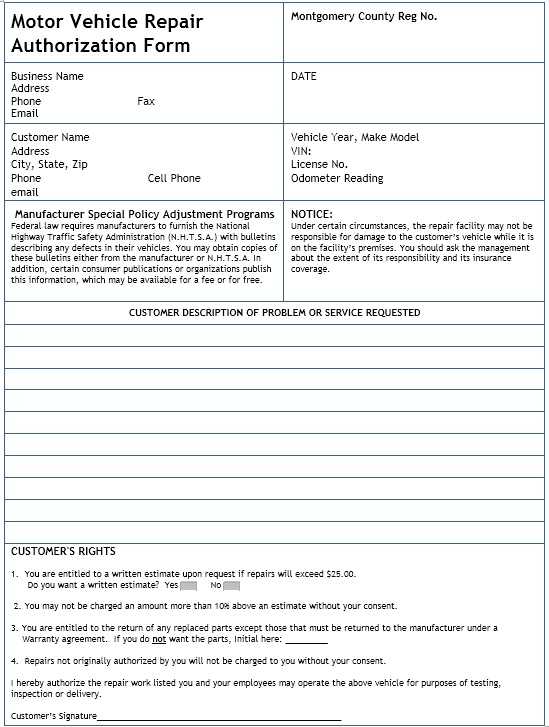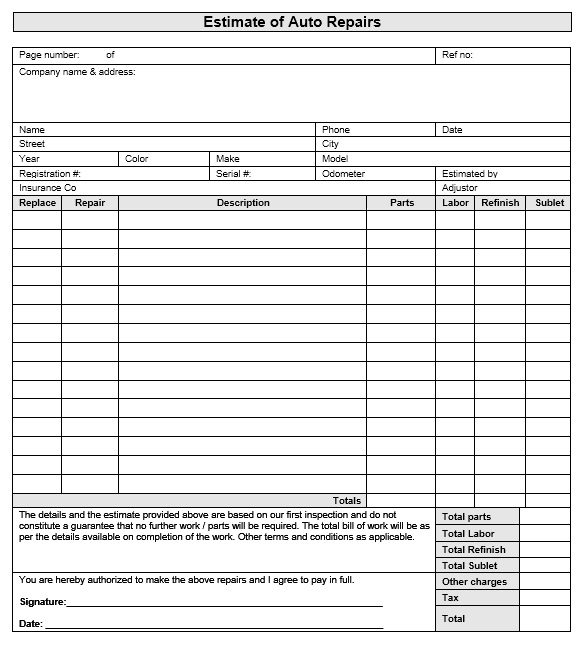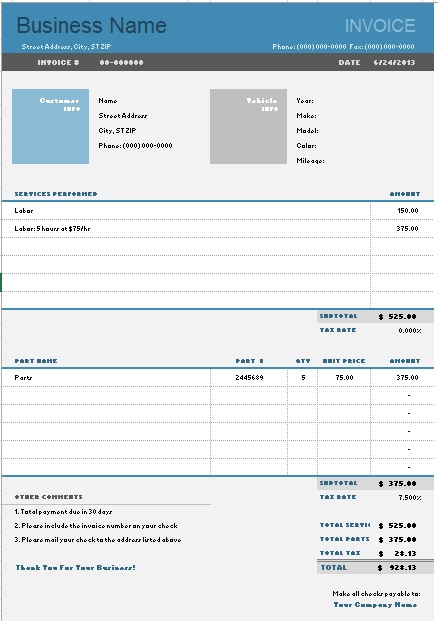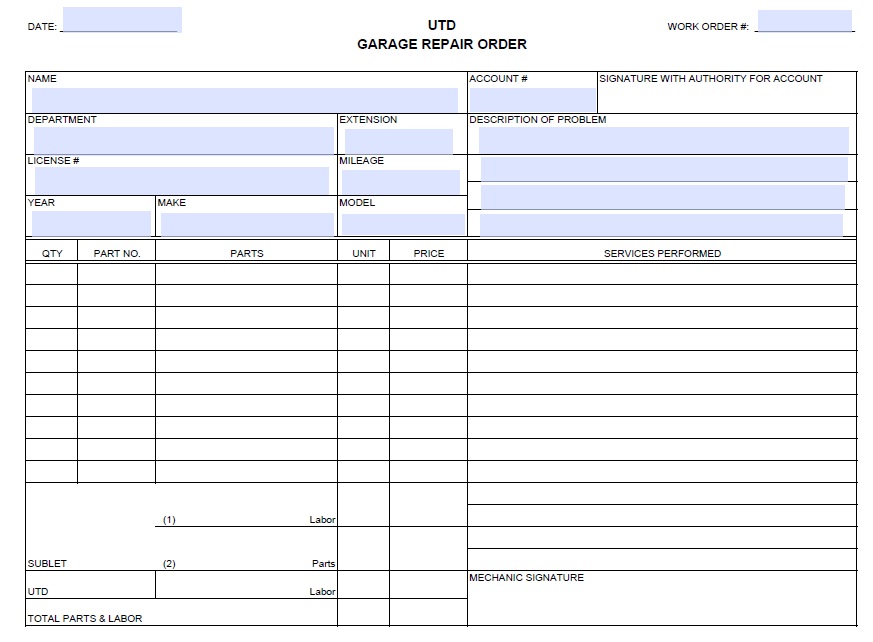It is very usual these days to depend on our vehicle for commuting on a trip or even in emergencies. As vehicles are no horses that only graze and serve us, we must take care of them and repair these well in time or else we might find ourselves in trouble. There are a number of factors to be considered while going for a repair or routine maintenance, for example, the problem, the right shop, and of course our rights! When we buy a car we should carefully follow the instructions in the manual and ask the manufacturer for authorized workshops in our locality.
As a rule of thumb fixing small problems in time so as to avoid bigger ones, car key indicators and its performance are to be watched out for the possible need for a potential repair. The most common mistake by most of the vehicle owners is not changing lubricants in time. These minor tasks not only increase vehicle life but keep you safe.
Contents
Using Auto Repair Estimate Templates
Usually, the repair work begins with an estimate thereof, the same are usually sanctioned by law under most of the jurisdictions. Ideally, an estimate should include the cost of the parts to be replaced. This will also be followed by labor for the same. If there are alternative options of parts or means of repair and service, they are also to be mentioned in accordance with the customer’s preference. Sticking to it must be ensured. The estimate may be based on items or any other format that suits the customer’s needs and internal reporting requirements. It should be easy to understand, simple, and provide all necessary information in detail.
An estimate is usually to be signed by the owner of the car after completely understanding it. This is the customer’s assent to the terms therein and permission to do the necessary repairs and services. This agreement also signifies the fact that the customer is willing to pay the amount mentioned in the estimate. At times car needs detailed checking before sanctioning some repair, these costs might be in addition to the repair costs and must be disclosed to the customer separately. An estimate must also clearly identify parts that are to be purchased from other vendors or services, as the case may be.
Free Auto Repair Estimate Templates
It is very important to understand that an estimate is a mere offer by the repair shop and does not constitute any liability. It should be ensured that diagnosis and repair estimate is made by a qualified staff and authorized workshop. It should also mention guarantees, if any. As general advice, your car needs a repair if it has unusual sounds, or you smell leakage. If you see any unusual activity like this, it’s time for repair. As to the details, it should contain the complete shop address and details as required by law and industry practice along with the details of the vehicle and owner. It should also be understood that there several car repair estimates and so is the related costing. Like old days, your car is your companion take care of it and it will take care of you!
Best Practices of Auto Repair Estimates
Accurate and professional auto repair estimates are critical in establishing trust with the customer, transparency, and efficient operation of the repair shop. Regardless of whether it is a minor maintenance job or a major repair, estimates will serve as a pricing guide as well as a means of communication between the mechanic and the customer. Following best practices enhances customer satisfaction and reduces friction in the workflow management as well as fewer disputes.
Gathering Comprehensive Vehicle and Damage Information
Gathering detailed information about the vehicle such as make, model, year, VIN, and current mileage is the first step towards an accurate estimate. It is equally important to conduct a thorough evaluation and document visible and reported problems clearly. Holding a comprehensive diagnostic tool and visual check affords the technician the opportunity to identify additional problems that may be concealed and that could introduce later revisions to the estimate and therefore erode the confidence of the customer. Thus, this thoroughness will make sure that all parts, labor, and additional services are taken into account from the beginning.
Providing Transparent Breakdown of Costs and Timeframes
Offering a detailed, itemized cost breakdown is one of the most treasured practices in auto repair estimation. Every facet of the repair should be broken down separately—parts, labor hours, additional fees, and taxes—so the customer understands exactly what he or she pays for. Since actual time estimates are given for the work, this also helps to set customer expectations and assists the shop in scheduling repair work. With the same labor charges and standard parts prices assessed on any given job, this method provides equity and consistency in estimating.
Communicating and Updating Estimates Promptly
As soon as an estimate is made, it should be reviewed with the client to confirm the understanding of the work planned for approval. Any alterations that come up during the ongoing repair like unforeseen damage or unavailability of parts should call for immediate updating of the estimate to be approved by the customer before proceeding with that repair. Good communication such as this should help prevent misunderstandings and readily shows one to be honest and professional.
Following these best practices in auto repair estimates not only enhances the reputation of a repair shop but also contributes to smoother operations, repeat business, and long-term customer loyalty.
Common Mistakes to Avoid in Auto Repair Estimates
Auto repair estimates must be precise and honest to keep satisfied customers and the workshop’s reputation intact. Even specialists can make a major error that results in complaints, loss of money, or loss of efficiency in operations. Avoiding these errors are essential in producing accurate, clear estimates in order to instill trust and encourage repeat business.
Underestimating Labor and Overlooking Hidden Issues
In the field of auto repairs, one of the common mistakes that are made regarding estimates is a tendency for under estimating in terms of the hours spent on every repair work. This usually happens because technicians rely solely on what they see or rush through their diagnostics and come to some kind of conclusion without understanding the full extent of the problem. In fact, some hidden damages or what-if scenarios can lead to estimates being changed again and further hold up the customer. Trust me, precise assessments in labor can only be done through thorough diagnostics, industry-standard labor guides, and an accurate view of how long it may take to actually perform the task under real shop conditions.
Failing to Itemize Parts and Services Clearly
To another major sin, there are vague or general estimates and the reports do not really specify or thoroughly breakdown the parts, labor, and added services. Lack of clarity may raise doubts in clients’ minds as to whether the charges may be legitimate, particularly if they really seem high. Ambiguous estimates not only create confusion but also tend to erode trust. In contrast, a clear itemized estimate that spells out what all went into the repair builds trust and makes it much easier to explain the costs to customers.
Not Communicating Estimate Changes Promptly
Findings during repairs will often reveal other problems or complications needing modification of the original estimate. An example of this common error is carrying on with the repair without informing the customer of the new costs in a timely manner. This results in disputes at the time of payment and sends the one customer-so-affectionate relationship spiraling down the drain. Therefore, the best practice is to revise the estimate and seek customer approval before proceeding with any extra work.
By avoiding these common estimating errors, auto repair professionals can ensure a smoother workflow, minimize disputes, and reinforce a reputation for honesty and accuracy within a highly competitive industry.













